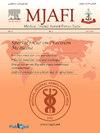Determinants of outcomes of childhood severe Malaria: A multi-centric study
Q2 Medicine
引用次数: 0
Abstract
Backgrounds
Severe malaria (SM) has remained a major global health challenge, disproportionately affecting children in endemic areas. Understanding the factors that influence childhood SM outcomes is critical for developing contextualized early warning scores, effective prevention, and treatment strategies.
Methods
This is a retrospective, multicenter study conducted between year 2019 and 2022 involving children diagnosed with SM based on World Health Organization (WHO) diagnostic criteria. Multivariate logistic regression was used to identify the determinants of in-hospital mortality from significantly associated factors on bivariate analysis.
Results
Of the 7765 children admitted to emergency rooms, 997 (12.8%) had SM, with a median age of 4 (IQR: 2.7). M: F ratio of 1.2:1. Anemia (353: 35.4%), hemoglobinuria (348: 34.9%), cerebral malaria (331: 33.1%), and prostration (325: 32.6%) were the most common manifestations of SM. Half (494, 49.5%) of the children had only one form of SM, followed by a combination of three forms (270: 27.1%) of SM. Nine of 43 children with severe acute kidney injury received peritoneal dialysis, while 19 received haemodialysis. Severe shock (75.0%) and a patient with respiratory distress syndrome received mechanical ventilation support. The determinants of increased mortality included the first day of admission [OR (95% CI):24.44 (9.792, 61.007)], and manifestations of shock with a 17-fold [OR (95% CI): 17.682 (4.159, 75.196)] increased mortality.
Conclusion
SM still carries a significant risk of increased mortality, the need for dialysis, and mechanical ventilation support. The first 24 h after admission, as well as the shock, are determinants of increased mortality.
儿童重症疟疾结局的决定因素:一项多中心研究
严重疟疾(SM)仍然是一个主要的全球卫生挑战,对流行地区的儿童造成了不成比例的影响。了解影响儿童SM结果的因素对于制定情境化的早期预警评分、有效的预防和治疗策略至关重要。方法:这是一项回顾性的多中心研究,于2019年至2022年进行,涉及根据世界卫生组织(WHO)诊断标准诊断为SM的儿童。采用多变量logistic回归从双变量分析的显著相关因素中确定住院死亡率的决定因素。结果急诊收治的7765名儿童中,997名(12.8%)患有SM,中位年龄为4岁(IQR: 2.7)。M: F比为1.2:1。贫血(353:35.4%)、血红蛋白尿(348:34.9%)、脑性疟疾(331:33.1%)和虚脱(325:32.6%)是SM最常见的表现。一半的儿童(494人,49.5%)只有一种形式的SM,其次是三种形式的SM的组合(270人,27.1%)。43例严重急性肾损伤患儿中9例行腹膜透析,19例行血液透析。严重休克(75.0%)和1例呼吸窘迫综合征患者接受机械通气支持。死亡率增加的决定因素包括入院第一天[OR (95% CI):24.44(9.792, 61.007)]和休克表现,死亡率增加17倍[OR (95% CI): 17.682(4.159, 75.196)]。结论sm仍有显著的死亡率增加、透析和机械通气支持需求增加的风险。入院后的前24小时以及休克是死亡率增加的决定因素。
本文章由计算机程序翻译,如有差异,请以英文原文为准。
求助全文
约1分钟内获得全文
求助全文
来源期刊

Medical Journal Armed Forces India
Medicine-Medicine (all)
CiteScore
3.40
自引率
0.00%
发文量
206
期刊介绍:
This journal was conceived in 1945 as the Journal of Indian Army Medical Corps. Col DR Thapar was the first Editor who published it on behalf of Lt. Gen Gordon Wilson, the then Director of Medical Services in India. Over the years the journal has achieved various milestones. Presently it is published in Vancouver style, printed on offset, and has a distribution exceeding 5000 per issue. It is published in January, April, July and October each year.
 求助内容:
求助内容: 应助结果提醒方式:
应助结果提醒方式:


